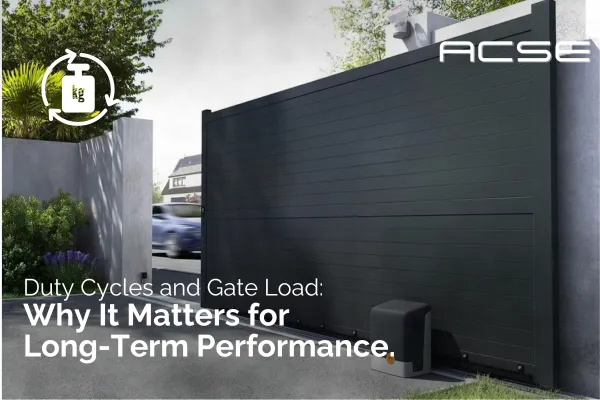
Understanding Duty Cycles and Gate Load: Why It Matters for Long-Term Performance
Whether you’re installing an automated gate system at a residential home or managing access to a high-traffic commercial site, two of the most important technical aspects to get right from the start are duty cycle and gate load. These are not just engineering buzzwords—they directly impact how long your gate system will last, how safely it will operate, and how much it will cost you in repairs or replacements over time.
In this article, we’ll break down what duty cycle and gate load really mean, how they influence performance, and how end-users and decision-makers can make smarter choices when working with professional installers like ACSE.
What Is Duty Cycle and Why Does It Matter?
Definition
The duty cycle of a gate operator is the number of times it can open and close within a given time frame—usually measured in cycles per hour or percentage of time active. For example, a gate operator rated for a 30% duty cycle can operate for 18 minutes every hour (30% of 60 minutes).
Why It’s Important
Duty cycle determines how much work the motor can handle without overheating or wearing out prematurely. Using a residential-grade motor for a busy business park is a common mistake that leads to breakdowns.
Common Ratings
Residential Duty (10-30%): Ideal for 5–15 cycles/day.
Light Commercial (30-50%): Designed for moderate use such as small communities or low-volume lots.
Heavy Duty/Industrial (50-100%): Suitable for high-traffic areas like industrial sites, gated communities, or government facilities.
Understanding Gate Load
Definition
Gate load refers to the weight and size of the gate, including wind load and other physical resistance factors (like slope, friction, and hardware resistance).
Gate operators are rated not just by cycle frequency, but also by how much weight they can reliably move over time.
What Influences Gate Load?
Gate Material: Steel is heavier than aluminum or vinyl.
Gate Dimensions: Taller and wider gates have more surface area and resistance.
Wind Exposure: In open areas, wind can create significant resistance, especially on solid panel gates.
Terrain & Hardware: Sloped driveways and worn rollers add load.
What Happens When You Mismatch Capacity and Requirements?
If you install a low-duty-cycle operator on a high-use gate—or an underpowered motor on a heavy gate—you’re asking for:
Frequent Overheating: Leading to system shutdowns and potential fire hazards.
Motor Burnout: Causing costly replacements.
Premature Wear: Reducing operator lifespan by up to 70%.
Safety Risks: Malfunctions that lead to uncontrolled gate movement or entrapment hazards.
How to Evaluate Usage Frequency (Duty Cycle Needs)
Ask yourself:
How many times will the gate open/close daily?
Are there rush hour peaks (e.g., school, shift changes)?
Will it be used for pedestrians, delivery trucks, or both?
Sample Daily Use Scenarios
Property Type
Typical Daily Cycles
Recommended Duty Cycle
Single-family home
5–10
10–30% (Residential)
Small office
20–40
30–50% (Light Commercial)
Gated community (20+ units)
100+
80–100% (Heavy Duty)
Distribution center
200+
100% (Industrial)
Matching Gate Operator to Gate Load and Duty Cycle
When specifying a gate system, your installer should consider:
Weight of the gate in pounds.
Gate dimensions (height x width).
Frequency of use.
Type of operation (swing, slide, vertical lift, etc.).
Wind exposure or slope resistance.
Example:
A 600-lb solid swing gate on a windy hilltop with 50+ daily cycles should not use a light-duty residential operator, even if it's installed at a home. It should be sized for performance, not just property type.
Best Practices for Long-Term Performance
✔ Always over-spec if unsure. Go slightly above calculated needs to provide a safety buffer.
✔ Use a timer-to-close with caution. Frequent cycles in short periods can overwork low-duty operators.
✔ Add proper support hardware. Heavy-duty rollers, hinges, or guide systems reduce operator strain.
✔ Maintain your system regularly. A properly serviced operator performs more efficiently and lasts longer.
✔ Work with certified professionals. ACSE ensures your system is correctly sized and compliant with UL 325 and ASTM F2200.
What to Ask Your Installer or Integrator
What is the exact duty cycle rating of the operator?
Is this motor rated for my gate’s weight and size?
What happens if usage increases in the future?
Will this system be affected by wind, slope, or gate material?
The ACSE Advantage: Precision in Planning
At ACSE, we don’t just specify, install, and sell gate operators —we engineer long-lasting, compliant access solutions. Our team performs:
Site assessments
Usage evaluations
Load and stress calculations
Equipment specification with performance margins
Detailed, scalable designs that allow for future upgrades
With proper planning and expert installation, your automated gate system can deliver decade-level performance without recurring failures.
Ready to upgrade or specify a new gate system? Contact ACSE today and let us design a solution that works as hard—and smart—as your property requires.

